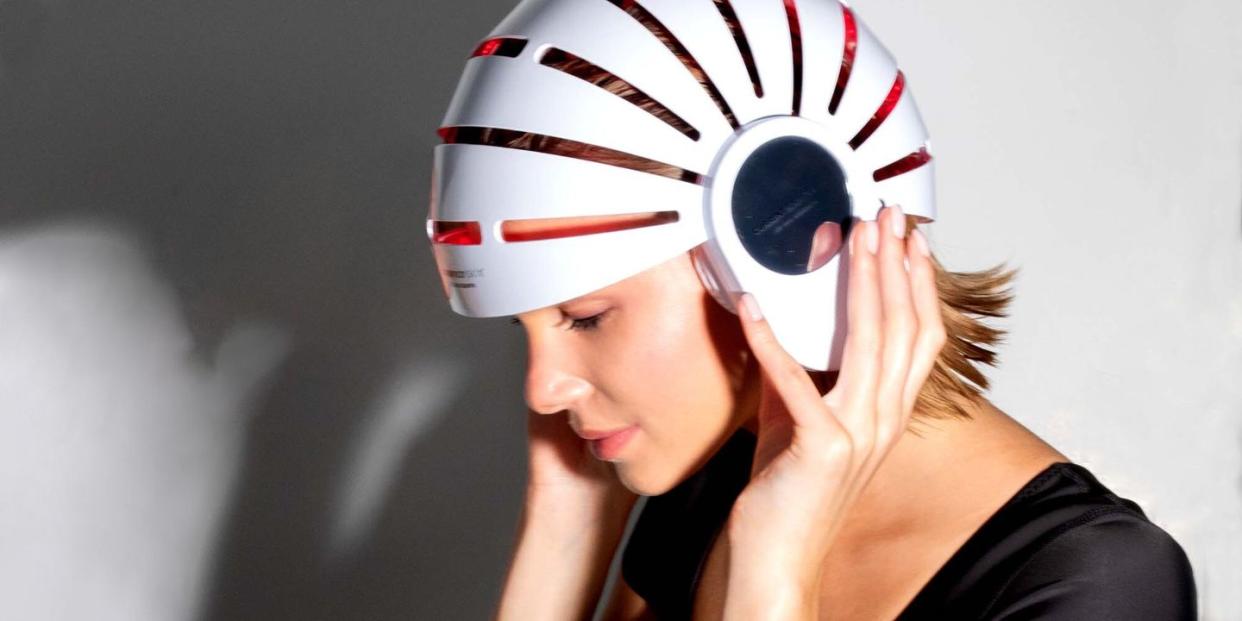How to use red light therapy to address hair loss and thinning

Hair loss and thinning is more common than you might think. In fact, more than 50 percent of women will experience noticeable hair loss in their lifetime, per Cleveland Clinic. With that in mind, it's not uncommon to be, at the very least, curious about the latest innovations in hair loss treatments.
In recent years, red light therapy has become an especially popular method for treating hair loss. “Red light therapy (RLT) involves exposing the skin to safe wavelengths of light in order to address a number of skin concerns, including signs of aging, stretch marks, scars, hyperpigmentation, and acne,” board-certified cosmetic dermatologist Dendy Engelman, MD, FACMS, FAAD told Women's Health. “Low wavelength red light produces a biochemical effect in cells to make more energy, which in turn helps cells work more efficiently to rejuvenate and repair damage.”
Typically, red light therapy treatments that address common skin concerns are done in-office with dermatologists or aestheticians, but you can also do one at-home with an LED face mask. For treating hair loss, though, you can find red lights in FDA-approved devices headbands, caps, and even combs.
Meet the experts: Dendy Engelman, MD, FACMS, FAAD, is a board-certified cosmetic dermatologist at Shafer Clinic in New York City. Ellen Marmur, MD, is a board-certified dermatologist, founder of Marmur Medical, and Women's Health Advisory Board member. Karyn Grossman, MD, is a board-certified dermatologist and founder of KarynG.
Below, learn all about what red light therapy is, how it works, the risks, and other tips for managing hair loss from top experts.
What is red light therapy?
Red light therapy is a painless treatment that uses the visible wavelength of light in the red spectrum. When it comes to hair growth, the light (usually around 630 nanometers) goes deep into the skin to where it helps to stimulate hair follicle to encourage growth, says board-certified dermatologist Ellen Marmur, MD. She adds that it uses photobiomodulation—a process meant to induce cell proliferation and enhance stem cell differentiation, per the Journal of Clinical Medicine.
Can red light therapy help with hair loss?
Red light therapy is a tested and proven way to promote hair growth. However, the reason someone is losing hair to begin with determines whether or not treatment will be effective.
Conditions like seborrheic dermatitis, a genetic and hormone-related rash similar to dandruff, cause inflammation, and therefore, hair loss. "Red light will help reduce the inflammation in the skin and allow the hair root to work better," says Dr. Marmur. For women with pattern hair loss in their 30s and 40s, red and blue light therapy can prolong their antigen phase (also called the growth phase). "By prolonging that phase of growth, you'll get more hairs that are growing," says Dr. Marmur.
Still, if your hair loss started 15 years ago and you have a shiny scalp, the follicles may be too small for new growth, adds Karyn Grossman, MD, a board-certified dermatologist. "The ideal candidate is somebody who's beginning to lose their hair or has hair thinning," she says.
Overall, patience is key. It takes about three to four months for baby hairs to grow and six to 12 months to really see a difference. "Some people will use it every day for six months or so, and then they'll go down to a maintenance level of three times a week," says Dr. Marmur. "It really depends on what your cause and trajectory is."
What are the side effects of red light therapy?
While there aren't a ton of downsides to using red light therapy for hair growth, it is possible to experience some side effects if you overdo it. For starters, it's important to remember that when using LED lights, "the light emitting diodes will give off a little range of light spectrum," says Dr. Marmur. "So red light [is] very close to the infrared wavelength of light."
Why does that matter? Marmur explains that this can cause heat reactions as well as thinning of fat on the scalp, which can cause indentations or wrinkling of the skin. She adds that feeling a stinging sensation can also indicate over-usage.
Other ways to address hair loss and thinning
Reduce stress: Generally speaking, reducing stress may increase the possibility of your hair growing back, per Mayo Clinic. For example, if you have a habit of twirling, pulling, or picking at your hair because of stress, finding new coping mechanisms will give your hair time to recover.
Try different supplements: While eating a nutritious diet ensures you'll get all the nutrients you need to support healthy hair, there isn't one particular food that holds the key to hair growth. So if you need a little assistance, Dr. Grossman suggests trying supplements. No, not the miracle gummies your favorite celebrity sponsors on Instagram. Think something like collagen supplements, for example, which can be helpful if you don't get enough intake from animal protein.
Get a full blood panel done: An underlying health condition can cause hair loss, which is why Dr. Marmur suggests getting bloodwork done. "You could have an iron deficiency or a thyroid problem and not even know it," she says. "Those are very important and reversible causes of hair loss."
Pay attention to your styling habits: Tight ponytails, braids, buns, and other slicked-back styles can pull on the hair follicle, leading to breakage or hair loss. "Hair extensions can also contribute to hair loss due to irritation from adhesive or traction," says Dr. Grossman. "Eliminating those can also help."
You Might Also Like


